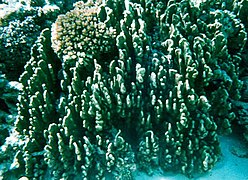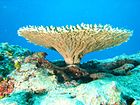Синий коралл
| Синий коралл | |
|---|---|

| |
| Научная классификация | |
| Домен: | Эукариота |
| Королевство: | Животное |
| Phylum: | Cnidaria |
| Class: | Octocorallia |
| Order: | Scleralcyonacea |
| Family: | Helioporidae |
| Genus: | Heliopora |
| Species: | H. coerulea
|
| Binomial name | |
| Heliopora coerulea Pallas, 1766
| |
Синий коралл ( Heliopora coerulea ) - это вид колониального коралла . Это единственный восьмикультор, который, как известно, производит массивный скелет. [ 3 ] This skeleton is formed of aragonite , similar to that of scleractinia . Отдельные полипы живут в трубах внутри скелета и соединены тонким слоем ткани на внешней стороне скелета.
Описание
[ редактировать ]The blue coral is the only extant octocoral with a massive skeleton,[ 3 ] который состоит из фиброкристаллического арагонита (карбонат кальция). It is a hermatypic zooxanthellaete species with either blue or green-grey polyps located within its skeleton, with each containing eight tentacles. Его колонии либо столбчатые, тарелки, либо разветвленные. [ 4 ] [ 5 ] Это толерантный вид и используется в морских аквариумах .
Железные соли придают скелету Heliopora coeruea его уникальный цвет, который обеспечивает легкое распознавание в ископаемых обнажениях. [ 6 ] Таким образом, он довольно обильно в палеонтологии , при этом окаменелости указываются, что вид остался неизменным со времен мелового . [6]
Blue coral has shown a particular resistance to thermal changes in their environments and have actually grown more in warmer temperatures.[7]
-
Live colony
-
Close-up on live polyps (notice the 8 arms)
-
Preserved skeleton, showing the typical color
-
idem
-
Close-up
Distribution
[edit]Despite being common in some areas and having a large range, the blue coral has been given the conservation status of a vulnerable species by the IUCN. Its population is unknown but it is believed to be decreasing in line with the global destruction of coral reefs; it is threatened by aquarium harvesting, bleaching, habitat destruction, the acidification of oceans, and climate change.[1] It is found in the eastern and western Indian Ocean, and the eastern central, western central, northwestern, and southwestern Pacific Ocean; its range includes the Great Barrier Reef, Australia, Japan and the Ryukyu Islands. Its largest colony is believed to be located off Ishigaki Island in the Yaeyama Islands, southwestern Japan. It is found in reefs with depths below 2 m (6.6 ft), or reefs exposed to waves, flats, intertidal regions, and sometimes in marginal habitats.[1] The blue coral is listed under Appendix II of CITES.[1]
The world's largest deposit of blue coral is in Shiraho, Japan.[8] This deposit however was threatened by the possible development of an airport in 1989.[8] The airport was to be placed over the coral bed and would have resulted in the destruction of these rare coral. Transnational organizations such as the World Wide Fund for Nature stepped in and with public support managed to prevent the construction. The organization also constructed a field research station at the site to further study the corals.[8] The airport was eventually built but at a location where it wouldn't harm the corals. The Fund then attempted to implement their typical procedures of creating protected areas for the coral. However, the prior support from the public disappeared. The residents of Shiraho were opposed to the creation of such areas.[8]
Conservationists thus took a different approach. They attempted to further connect the community of Shiraho with the sea, beyond just fishing, to try and inspire a desire to conserve the area. What resulted was the revitalization of sanizu.[8] It is a local celebration where the people give back to the sea gods. The tradition had decreased in prevalence over the years due to a variety of reasons including economic pressure and other local socioeconomic conditions.[8] The Fund was unable to initiate the celebration so instead they provided the tools and resources for it. This led to a large-scale sanizu celebration where both locals and conservationists connected with the sea.[8]
Taxonomy
[edit]Heliopora coerulea was described by Pallas in 1766.[9]
References
[edit]- ^ Jump up to: a b c d Obura, D.; Fenner, D.; Hoeksema, B.; Devantier, L.; Sheppard, C. (2008). "Heliopora coerulea". IUCN Red List of Threatened Species. 2008: e.T133193A3624060. doi:10.2305/IUCN.UK.2008.RLTS.T133193A3624060.en. Retrieved 19 November 2021.
- ^ "Appendices | CITES". cites.org. Retrieved 2022-01-14.
- ^ Jump up to: a b Barnes, Robert D. (1982). Invertebrate Zoology. Philadelphia, PA: Holt-Saunders International. p. 169. ISBN 0-03-056747-5.
- ^ "Heliopora coerulea". Arkive.org. Archived from the original on 2015-09-05. Retrieved 17 August 2015.
- ^ Leon P. Zann; Lesley Bolton (September 1985). "The distribution, abundance and ecology of the blue coral Heliopora coerulea (Pallas) in the Pacific". Coral Reefs. 4 (2): 125–134. doi:10.1007/BF00300871. S2CID 64814.
- ^ Jump up to: a b Gornitz, V (2009). Encyclopedia of Paleoclimatology and Ancient Environments. Springer. pp. 202–203. ISBN 978-1402045516.
- ^ Guzman, Christine; Atrigenio, Michael; Shinzato, Chuya; Aliño, Porfirio; Conaco, Cecilia (2019-09-27). "Warm seawater temperature promotes substrate colonization by the blue coral, Heliopora coerulea". PeerJ. 7: e7785. doi:10.7717/peerj.7785. ISSN 2167-8359. PMC 6768060. PMID 31579631.
- ^ Jump up to: a b c d e f g Claus, C. A. 2020. Drawing the Sea Near: Satoumi and Coral Reef Conservation in Okinawa. Minneapolis: University of Minnesota Press
- ^ "Heliopora coerulea". World Register of Marine Species. Retrieved 17 August 2015.






